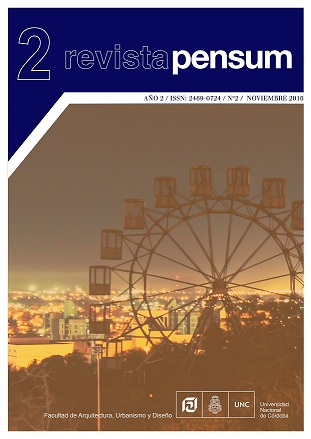Design theory: Categories and epistemic approaches for a new image of a discipline
DOI:
https://doi.org/10.59047/2469.0724.v2.n2.16430Keywords:
Representations, Problem-setting, Design research, Epistemology, Design.Abstract
This article reviews the classical conception of design theory and onto-epistemic foundations that determine the possibility of a better understanding of its constituent processes and impacts for the habitat transformation. The objectives are to review the mainstream in design theory and reflect on the need to create new bases for design studies in general and for architectural design in particular. Through philosophical method, conceptual elucidation and theoretical systematization the new categories for a new design image in the current context issues are addressed. Results show three new categories to advance a new image of the design theory as problematization, representation and design research.References
Buchanan, R.; Doordan D. y Margolin, V. (2010). The Designed World: Images, Objects, Environments. Oxford: Berg Publishers.
Burgos, C. (2014). La praxis constructiva del diseño tecnológico: un análisis de sus dimensiones ontológicas, epistemológicas y metodológicas. Tesis Doctoral, Euskal Herriko Unibertsitatea, Donostia: Lógica y filosofía de la ciencia.
Burgos, C. e Ibarra, A. (2014). Teoría del diseño: de las lógicas del objeto-problema a las lógicas de los procesos constitutivos. Representaciones, 2014, vol. 10 n°1, pp. 21-44.
Capdevila Werning, R. (2012). Construir símbolos y hacer mundos. La dimensión epistemológica y ontológica de la Arquitectura. Enrahonar. Quaderns de Filosofia 49, 107-120.
Carnap, R. (1956). “El carácter metodológico de los conceptos teóricos”, en Olivé-Pérez Ransanz (eds.), 1989, 70-115.
Callon, M. (2001). Redes tecno-económicas e irreversibilidad. Redes, 8(17), pp. 85-126.
Cassirer, E. (1953). Substance and Function & Einstein’s Relativity Theory, Dover, New York.
Coyne, R. (2005). “Wicked Problems Revisited”, Design Studies, vol. 26, no. 1, pp. 5-17.
Cross, N. (2011). Design thinking: Understanding how Designers Think and Work, Berg, New York.
Cross, N. (1999). Natural intelligence in design. Design Studies, 20(1), pp. 25-39.
Cross, N.; Christiaans, H. y Dorst, K. (1996). Analyzing Design Activity, Wiley, Chichester, UK.
Dewey, J. (1938). The theory of inquiry. New York: Henry Holt and Company.
Goodman, N. (1978). Ways of Worldmaking, Hackett Publishing Company, Indianapolis.
Hacking, I. (1983). Representing and intervening: Introductory topics in the philosophy of natural science, Cambridge: University Press.
Harfield, S. (2007). “On Design Problematization: Theorizing Differences in Designed Outcomes”, Design Studies, vol. 28, no. 2, pp. 159-173.
Hutchins, E. (1996). Cognition in the Wild, The MIT Press, Cambridge, MA.
Jacques, R. y Powell, J. (1980). Design: Science: Method. Surrey: Westbury House.
Kroes, P. (2002). Design methodology and the nature of technical artefacts. Design Studies, 23(3), pp. 287-302.
Kroes, P. y Meijers, A. (2006). The dual nature of technical artifacts. Studies in History and Philosophy of Science, 37, pp. 1-4.
Ladrière, J. (1978). El Reto de la Racionalidad: La Ciencia y la Tecnología Frente a las Culturas, Unesco–Sígueme, Salamanca.
Latour, B. (2005). Reassembling the social. Oxford: Oxford University Press.
Lawson, B. y Dorst, K. (2009) Design Expertise, Oxford: Elsevier.
Margenau, H. (1935). “Methodology of Modern Physics”, Philosophy of Science, vol. 2, no. 2, pp. 48-72.
Popper, K. (1972). Objective knowledge: An evolutionary approach, Oxford: Clarendon Press.
Porter, W. y Goldschmidt, G. (2001). “Design Representation”, Automation in Construction, vol. 10, no. 6, pp. 659-661.
Reichenbach, H. (1938). Experience and prediction: analyses of the foundations and the structure of knowledge. Chicago: University of Chicago Press.
Simon, H. (1973). “The Structure of Ill Structured Problems”, Artificial Intelligence, vol.4, pp.181 201.
Simon, H. (1996). The Sciences of the Artificial, (3° ed.) Cambridge: The MIT Press.
Downloads
Published
Issue
Section
License
Authors who publish in this journal agree to the following terms:
a. Authors retain copyright and guarantee to the journal the right to be the first publication of the work as well as licensed under a Creative Commons Attribution-ShareAlike 4 license.
b. Authors may separately establish additional agreements for non-exclusive distribution of the version of the work published in the journal (e.g., placing it in an institutional repository or publishing it in a book), with an acknowledgement of its initial publication in this journal.
c. Authors are permitted and encouraged to disseminate their work electronically (e.g., in institutional repositories or on their own website) before and during the submission process, as this may result in productive exchanges, as well as earlier and greater citation of published work (See The Effect of Open Access).
d. 4.0 International Creative Commons Attribution-ShareAlike 4.0 License.













